Boxer (armoured fighting vehicle)
The Boxer is a multirole armoured fighting vehicle designed by an international consortium to accomplish a number of operations through the use of installable mission modules. The governments participating in the Boxer programme have changed as the programme has developed. The Boxer vehicle is produced by the ARTEC GmbH (armoured vehicle technology) industrial group, and the programme is being managed by OCCAR (Organisation for Joint Armament Cooperation). ARTEC GmbH is based in Munich; its parent companies are Krauss-Maffei Wegmann GmbH and Rheinmetall Military Vehicles GmbH on the German side,[5] and Rheinmetall Defence Nederland B.V. for the Netherlands.[6] Overall, Rheinmetall has a 64% stake in the joint venture.
| Boxer | |
|---|---|
 Australian Boxer in 2016 | |
| Type | Armoured fighting vehicle |
| Place of origin | Multinational |
| Service history | |
| In service | 2011–present (Afghanistan war) |
| Used by | See Operators |
| Production history | |
| Designer | ARTEC GmbH |
| Designed | 1998–2009 |
| Produced | 2009–present |
| No. built | 539 as of February 2020[1] |
| Specifications | |
| Mass | 24,000 kg (standard); 36,500 – 38,500 kg (combat);[2] 41,000 kg (technical)[3] |
| Length | 7.93 m (26 ft 0 in) |
| Width | 2.99 m (9 ft 10 in) |
| Height | 2.37 m (7 ft 9 in) (baseline vehicle) |
| Crew | Varies by role. In APC configuration – 3 + maximum of 8[2] |
| Armor | AMAP composite armour |
Main armament | various, depends on configuration |
| Engine | MTU 8V199 TE20 Diesel rated at EURO 3[4] 530 kW (711 hp) in A0/A1/A2 and 600 kW (805 hp) in A3 (see text for full details) |
| Power/weight | 16.1 kW/t (max weight @ 530 kW)) |
Operational range | 1,100 km (684 mi) |
| Maximum speed | 103 km/h (64 mph) |
A distinctive and unique feature of the vehicle is its composition of a drive platform module and interchangeable mission modules which allow several configurations to meet different operational requirements.
Other names in use or previously used for Boxer are GTK (Gepanzertes Transport-Kraftfahrzeug; armoured transport vehicle) Boxer and MRAV (Multi-Role Armoured Vehicle).[7] Confirmed Boxer customers as of April 2022 are Germany, the Netherlands, Lithuania, Australia and the UK. The Boxer has been produced and seen service in A0, A1 and A2 configurations. The UK Boxer will be of the A3 configuration. Australian deliveries are an A2/A3 hybrid.
Production history
The Boxer started in 1993 as a joint venture design project between Germany and France, with the UK joining the project in 1996. In November 1999, a £70 million contract for eight prototype vehicles (four each, Germany and the UK) was awarded. France left the programme in 1999 to pursue its own design, the Véhicule Blindé de Combat d'Infanterie (VBCI). In February 2001, the Netherlands joined the programme and an additional four prototypes were built for the Netherlands.[2] Boxer, then known as GTK/MRAV/PWV, was unveiled on 12 December 2002. The name Boxer was announced when the second prototype appeared. At this time the first production run was to have been 200 for each country.[8]
The UK Ministry of Defence announced its intention to withdraw from the Boxer programme and focus on the Future Rapid Effect System (FRES) in July 2003.[2] In October 2003, the first Dutch prototype was delivered. In October 2006 the Netherlands confirmed the procurement of 200 Boxers to replace the M577 and the support variants of the YPR-765 in the Royal Netherlands Army. Deliveries were scheduled to run from 2013 through to 2018, and within the RNLA the baseline Boxer is called the Pantserwielvoertuig (PWV).[8]
On 13 December 2006 the German parliament approved the procurement of 272 Boxers for the German Army,[9] to replace some of its M113 and Fuchs TPz 1 vehicles.[10][11] Production of Boxers had been scheduled to commence in 2004, but production was delayed and the first production example was delivered to the German Army in September 2009. Over seven years, prototypes accrued over 90,000 km of reliability trials and over 90,000 km of durability trials.[2] There are three production facilities for Boxer, one in the Netherlands (Rheinmetall) and two in Germany (Krauss-Maffei Wegmann and Rheinmetall).[2][8]
2010s
.jpg.webp)
In December 2015 it was announced that Germany had ordered an additional 131 Boxers worth EUR476 million[12] and that Lithuania had selected the Boxer.[12]
In August 2016 a EUR385.6 million production contract was placed by Lithuania for the supply of 88 Boxers, and at this time it was stated that 53 Boxers would be manufactured by KMW and the remaining 35 by Rheinmetall, with deliveries running 2017–2021. In Lithuanian service, the vehicle is designated as Vilkas (Wolf). The precise mix/number of Lithuanian vehicles was initially unclear but according to Janes, Lithuania will receive 91 Boxers in the A2 configuration, 89 as variants of the baseline IFV configuration, plus two driver-training vehicles. The exact breakdown is 55 squad-leader, 18 platoon-leader, 12 company-leader, and 4 command-post vehicles. A single IFV will be used for maintenance training. The first two vehicles (driver training configuration) were delivered in December 2017.[13] The first two Boxer in IFV configuration were delivered in June 2019 and at this time the Lithuanian MoD stated that 15 vehicles would be delivered in 2019 and that all 89 IFV variants would be delivered by the end of 2023.[14][15][3]
Most of the original German Army Boxer order was delivered in the A1 configuration. 40 APC and 16 command posts, however, were delivered in the A0 configuration; these were subsequently upgraded to the A1 configuration. In June 2017 it was announced that the Bundeswehr's Boxer A1 fleet would be upgraded to A2 standard. The first A2 Boxer was delivered in June 2015.[2] The differences between A1 and A2 configurations are relatively minor electrical and mechanical engineering changes.[11] The A2 standard resulted from operations in Afghanistan and incorporates changes in the drive and mission modules that include preparation for the integration of a driver vision system, changes to the stowage concept in both modules, changes to the gearbox, integration of a fire suppression system, modification of the RCWS, interface for an IED jammer, satellite communication system and other minor modifications."[16] The latest Boxer variant is the A3. The British are the first customer of the A3 in its entirety.[11]
In July 2017 ARTEC awarded the then Rheinmetall MAN Military Vehicles (RMMV) a €21 million contract to upgrade 38 Bundeswehr Boxer command vehicles to A2 configuration with work scheduled for completion in mid-2020. At this time the Bundeswehr also had 124 Boxer APCs, 72 ambulances and twelve driver training vehicles to upgrade to A2 status.[17]
In February 2018 it was announced that Slovenia had selected the Boxer as the basis for two new mechanised infantry battle groups. In November it was revealed that pricing issues had impacted the Slovenian procurement timeline and that a new proposal from industry was pending. According to the Slovenian MoD's initial release on the subject, funding had been allocated for the procurement of 48 vehicles in 2018-2020 for the first battle group, which was expected to become operational by 2022, followed by the second in 2025. The desired total was reported to be 112 Boxer (96 IFV, 16 mortar) plus a small number of driver training vehicles.[18] It was reported mid-2019 that the planned Boxer procurement had been suspended, the MoD deciding to conduct research and draw up a new comprehensive tactical study relating to the formation of a medium infantry battalion group, this likely to affect the procurement of 8×8 wheeled armoured vehicles. The ministry will then re-examine options available and make a decision on how to build a medium infantry battalion group capability.[19]
In July 2016 it had been announced that the Boxer was one of two vehicle types (from four) down-selected to take part in the 12-month Risk Mitigation Activity for Australia's Land 400 Phase 2 project, and in March 2018 it was announced that Rheinmetall Defense Australia (RDA) had been selected as the preferred tenderer for that project which at the time called for 211 vehicles, with a roll-out of initial vehicles by 2021 and deliveries scheduled to be complete by 2026. In Australian service the Boxer will replace the army's ageing fleet of 257 Australian Light Armoured Vehicles (ASLAV) that reach their life-of-type around 2021.[20][21][22][23][24] Under Rheinmetall's offering, the first batch of 20 to 25 vehicles will be built in Germany with Australians embedded into teams to learn the necessary skills before transferring back to Australia for the build of the remaining vehicles. RDA's Military Vehicle Centre of Excellence (MILVEHCOE) in Brisbane, Queensland, will be the hub for the production of the majority of the vehicles, the local build programme including about 40 local suppliers. These industrial opportunities will create up to 1,450 jobs across Australia, The acquisition and sustainment of the vehicles is costed at AUD15.7 billion (US$12.2 billion), acquisition worth AUD5.2 billion, the remaining AUD10.5 billion costed for sustainment over the vehicles' 30-year life.[25][26][12]
In March 2018 it was announced by the UK government that it was re-joining the Boxer programme, and in April 2018 it was announced that Boxer had been selected by the British Army to meet its Mechanised Infantry Vehicle (MIV) requirement. No details relating to quantity, cost, timeline or any contractual status were given.[27][28] It was first reported in October 2016 that the British Ministry of Defence had taken its first formal step towards government-to-government acquisition of Boxers.[29] At DSEI 2017, a Boxer in a Union Jack paint scheme was shown by Rheinmetall to promote the vehicle for the MIV requirement. In November 2017, a company of German army mechanised infantry equipped with 11 Boxers exercised with British Army units on Salisbury Plain. British Army sources denied that the exercise was linked to any decision on a procurement process for its MIV project.[30] In February 2018 it was reported that Artec had signed agreements with UK suppliers, this contributing to the fact that 60% by value of the MIV contract will be done in Britain, along with final assembly of the MIVs at facilities already owned by the consortium.[31][12]
In July 2018 there were three Boxer-related announcements made over a period of three days. On 17 July the Dutch MoD announced that the last Dutch Boxer had rolled off the production line, this being a cargo variant.[32] On 18 July the Lithuanian MoD announced that the country's first two Boxer prototypes had entered trials in Germany.[33] On 19 July 2018 the UK MoD disclosed its intent to order between 400 and 600 Boxers in four variants plus driver training vehicles, reference vehicles and support, with the first vehicles to be in-service by 2023. The contract will contain options to increase the quantity of vehicles by up to an additional 900.[34][12]
In March 2019 the Australian Ambassador to Germany inspected the first Boxer being delivered to the Australian Government under the Land 400 Phase 2 programme prior to its shipping to Australia,[35] and in July 2019 the first two of the 25 Boxer being built in Germany arrived in Australia. The 25 vehicles delivered from Germany were split 13 reconnaissance platforms and 12 multi-purpose vehicles (MPVs). Once in Australia, these vehicles received a number of Australia specific modifications prior to final delivery to the Army. The first vehicles were in use for training purposes by October 2020. Rheinmetall will deliver 211 Boxers to the Australian Army and in service Boxers will fill seven different roles on the battlefield: reconnaissance, command and control, joint fires, surveillance, multi-purpose, battlefield repair and recovery. The reconnaissance variant will account for 133 of the 211 vehicles and is equipped with Rheinmetall's Lance turret system and armed with a 30 mm automatic cannon.[36][37][12]
Also in July 2019 the first two Boxer (Vilkas) IFVs ordered by Lithuania were officially handed over to the MoD. The MoD stated that 15 Vilkas would be delivered in 2019 and all 89 vehicles would be delivered by the end of 2023.[12][3]
In September 2019 there were three Boxer-related announcements. On 10 September it was revealed that the target date for the UK's MIV programme to receive its main gate approval was 22 October 2019. It was reported that the business case for the purchase of an initial batch of 508 vehicles, valued at about GBP1.2 billion (US$1.48 billion), was currently under scrutiny by financial, commercial, and technical experts before receiving final approval by ministers. UK MoD officials submitted their final business case for the purchase of the Boxer MIVs on 9 September 2019 to meet the British Army's target of getting its first Boxer in service by 2023.[19] At the 2019 Defence and Security Equipment International exhibition (DSEI 2019) in London, Germany's Flensburger Fahrzeugbau Gesellschaft (FFG) presented an armoured recovery mission module (ARM) for the Boxer Christoph Jehn, FFG's project manager, stated the ARM was developed as a private venture from 2017. The company noticed Boxer users struggling to recover stranded vehicles with the aid of other Boxers and so decided to develop the bespoke mission module for the purpose. The ARM has an approximate weight of 13 tonnes, is manned by two personnel and connects to the Boxer using standard mechanical interfaces.[19] On 24 September 2019 it was announced that the first Boxer for the Australian Army had formally been handed over. The turretless vehicle was the first of 25 Boxers – 13 multipurpose and 12 reconnaissance variants – that are being manufactured in Germany through to 2021 to meet an early Australian capability requirement for familiarisation and training purposes. Production of the other 186 platforms began in late 2020/early 2021 at a military vehicle centre of excellence constructed by Rheinmetall at Ipswich, southwest of Brisbane, that formally opened in October 2020. This is the company's largest facility outside Germany.[19] Also in September 2019 reports emerged that Algeria had selected the Boxer and that production would commence shortly. As of Q1 2022 this had not been confirmed by ARTEC.[12][3]
In November 2019 the UK Ministry of Defence awarded ARTEC a US$2.97 billion (GBP2.3 billion) contract to deliver more than 520 Boxer vehicles in multiple configurations.[38]
2020s
In January 2020 in an interview with Shaun Connors of Jane's, Stefan Lischka, MD of ARTEC, stated that only 8% of UK Boxers would be manufactured in Germany with the remainder being assembled at and delivered from two sites in the UK, Rheinmetall BAE Systems Land (RBSL) at Telford and KMW subsidiary WFEL at Stockport. Production began in early 2023.[39]
In November 2020 it was announced that ARTEC consortium partners Rheinmetall Landsysteme and Krauss-Maffei Wegmann (KMW) had awarded two separate subcontracts to Rheinmetall BAE Systems Land (RBSL) and WFEL respectively for the local production of Boxers for the UK. RBSL and WFEL were selected by Rheinmetall and KMW respectively to be the UK Tier 1 suppliers and will operate one Boxer production line each. The value of KMW's contract has not been announced but is known to involve at least 480 drive modules being produced by WFEL in the UK, with under half of them being assembled by WFEL into full vehicles covering the Infantry Carriers, Specialist Carriers and Ambulance variants. The remaining drive modules being produced by WFEL will be shipped to RBSL to construct the other full vehicles in a number of variants, including the Specialist Carrier. Rheinmetall's contract with RBSL is worth US$1.15 billion (GPB860 million) and involves the manufacture of 262 Boxer vehicles at RBSL's assembly line in Telford, UK. All of these vehicles will either be the Specialist Carrier or Command vehicles.[38][40]
The German Federal Office of Bundeswehr Equipment, Information Technology and In-Service Support (Bundesamt für Ausrüstung, Informationstechnik und Nutzung der Bundeswehr, BAAINBw) awarded Rheinmetall a contract at the end of January 2021 to upgrade 27 more Boxer command vehicles to the A2 standard, this award bringing all the Bundeswehr's Boxer command vehicles up A2 standard.[41]
In December 2019 Germany's BAAINBw ordered 10 Boxer C-UAV (Counter UAV) systems. By June 2020 all elements of the system had passed the critical design review and live firing had been conducted. It was aimed to deliver the first systems to the Bundeswehr by the close of 2020. Boxers with the C-UASs are used to protect the NATO Response Force Very High Readiness Joint Task Force (VJTF) when Germany took leadership of the service in 2023.
The Bundeswehr announced in June 2020 that it would replace the Wiesel weapon carrier with a Kampfboxer mission module bringing the combination of a 30 mm cannon and Spike-LR anti-tank guided missile from the Puma infantry fighting vehicle to the wheeled platform.[42] The heavy weapon carrier will be the fifth version of the Boxer in service with the German Army and current planning calls for training to begin on the new heavy weapon carrier in 2025, with the first three infantry battalions to be equipped with the system by 2027. In March 2023 the German Army signed a contract with Rheinmetall Australia to procure these 128 Boxer CRVs from 2025 onwards.[43]
In September 2021 OCCAR announced a new reconnaissance vehicle mission module for the Bundeswehr known as the Joint Fire Support Team schwer (heavy)[44] differentiating it from the smaller Fennek scout car. The new variant will be centred around a sensor mast known as the Panoramic Above Armour Gimbal (PAAG) and built by Thales, with imaging sensors for visible to thermal infrared spectra and rangefinding and targeting lasers. Prototype delivery is expected in 2023 and full production in 2025.[45]
On 8 April 2022 it was disclosed that British Army would receive an additional 100 Boxers, bringing the order total to 623. No variant breakdown or other details was provided.[3]
By late 2023, ARTEC will have five Boxer assembly lines in operation which will have the capacity to produce 200 vehicles per year beginning in 2024.[46]
Design
The Boxer is an eight-wheeled multirole vehicle that at the time of its development easily exceeded most comparable vehicles in weight and dimensions. In recent years the size/weight differences between Boxer and its contemporaries has reduced considerably, with Boxer quoted to have a combat weight of 36.5 tonnes in 2016 in A1 and A2 configurations, while vehicles such as ST Kinetics' Terrex 3 had a quoted combat weight of 35 tonnes, and Nexter's VBCI, Patria's AMV and General Dynamics' Piranha V all weighing in around the 32 to 33 tonne mark. Current combat weight of the Boxer in A3 configuration is quoted as up to 38.5 tonnes.[19][47][48][49] However, Artec conducted trials in December 2021 with a Boxer weighing 41 tonnes. The vehicle, which was ballasted and without a mission module, traversed gaps up to 2.2m, climbed a 60° slope, and surmounted a 1m vertical step during trials. Artec managing director Stefan Lischka stated that there was no actual customer requirement for such a heavy Boxer at this time. The heaviest current version is the remote-controlled howitzer (RCH) version at 39 tonnes.[3]
The Boxer consists of two key elements: the platform/drive-line (the drive module) and the removable mission module.
Drive module
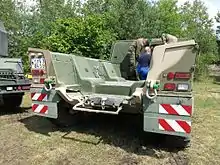
The drive module contains the wheels and the engine. It is also known as the platform or the drive-line module. The A iterations applied to the Boxer are specific to the drive module. Initial production examples were A0 and fewer than 60 were delivered. Main production was A1, followed in 2015 by A2. Current production standard depending on user is either A2 or A3. Australia is receiving an A2/A3 hybrid, in that it will receive the latest A3 drive module (rated at 38,500 kg) but with the A2 standard engine rating of 530 kW (711 hp)
The platform/drive module has the driver located front right, with the power pack to the left. The MTU/Allison powerpack can be replaced under field conditions in about 30 minutes and can, if required, be run outside of the vehicle for test purposes. Boxer is full-time all-wheel drive, the front four wheels steering. Suspension is double-wishbone coil springs, independent all round. Tyres are either 415/80 R27 or 415/80 R685, and a central tire inflation system and run-flat inserts are fitted.[2]
Mission module
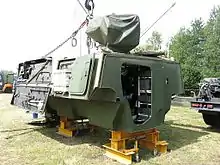
The mission module contains the mission-specific elements, such as weapons, equipment or crew. It is a key (and unique) feature of the Boxer. Mission modules are interchangeable pod-like units that are fitted to drive modules to form a complete mission variant vehicle. Mission modules are attached by four points and can be swapped within an hour under field conditions. The driver can access their compartment through the mission module or in an emergency via the large single-piece power-operated hatch above this position.[12]
Armament

Production Boxers are fitted with a variety of armament ranging from a 7.62 mm light machine gun in a remote weapon station to a 30 mm cannon in a turret. Numerous armament options are offered.
Most in-service Boxers are equipped with a remote weapon station for self-defense. Dutch vehicles are fitted with the Protector M151 RWS from Kongsberg fitted with a 12.7 mm heavy machine gun. German vehicles are usually fitted with the FLW-200 from KMW, which can be fitted with either a 7.62 mm MG3 machine gun, a 12.7 mm M3M HMG or a 40 mm GMW automatic grenade launcher. The FLW-200 has dual-axis stabilization and incorporates a laser rangefinder and a thermal imager.[50]
Lithuanian Boxers are fitted with the Israeli-made RAFAEL Advanced Defense Systems Samson Mk II RCT turret, mounting a fully stabilised Orbital ATK Mk 44 30 mm dual-feed cannon, 7.62 mm co-axial MG, and Spike-LR missiles. The turret is fitted with an independent commander's sight with both commander and gunner provided with thermal and daylight channels.
Australian Boxer CRVs mount the Rheinmetall Lance 30 mm two-man turret, fitted with the Rheinmetall Mauser MK30-2/ABM (air-bursting munition) dual-feed stabilised cannon and 7.62 mm coaxial MG. Turret traverse is all electric through a full 360° with weapon elevation from -15° to +45°. A Rheinmetall computerised fire-control system is installed, which allows stationary and moving targets to be engaged. The gunner has a Rheinmetall Stabilised Electro-Optical Sighting System (SEOSS), which typically has day/thermal channels and an eye-safe laser rangefinder. The commander has a Rheinmetall SEOSS panoramic sighting system, which allows hunter/killer target engagements to take place.[2]
The Lance Block 2 turret upgrade is to be integrated[51] with the Spike 2 anti-tank missile and the Iron Fist Active Protection System.
Latest Versions of the IFV will carry a Rheinmetall Lance 2 Block II shooting additional MELLS guided missiles.[52]
Protection
The Boxer is constructed from rolled all-welded steel armour to which the AMAP-B module-based appliqué armour kit can be fitted as required by mission threat estimates. AMAP-B modules are taken from the IBD Diesenroth AMAP modular armour package and are fitted to the vehicle with shock absorbing mountings.[53] Exact details of Boxer protection levels have now been classified. According to ARTEC, the vehicle will withstand anti-personnel and large anti-tank mines of an undisclosed type under the wheel, platform or side attack. It has previously been stated that Boxer's baseline armour is all-round resistant to 14.5 mm armour-piercing ammunition in accordance with STANAG 4569 Level 4.[12]
To increase survivability in case of armour penetration, the crew compartment is completely covered by an AMAP-L spall liner. The spall liner stops most of the fragments of the armour and projectile brought about by hull penetration. To further enhance crew protection, the seats are decoupled from the floor, this preventing the shock of a mine-detonation being directly transmitted to the crew. The roof armour of the Boxer is designed to withstand artillery fragments and top attack weapons such as bomblets fitted with a High-Explosive Anti-Tank (HEAT) warhead.[12]
The Boxer drive module A1 (as designated by the German BWB) is an upgraded version of the baseline A0 version of the Boxer drive module, with the primary difference being the installation of a mine protection package fitted to the belly and wheel stations of the vehicle. The vehicle is fitted an additional armour package focused on protecting against side and underbody blast threats. This consists of the AMAP-M and AMAP-IED packages. An unspecified electronic countermeasure (ECM) system was also fitted to counter IEDs. These changes result in a 1,058 kg weight increase for the A1 over the baseline A0 APC variant. For the A2 Boxer protection is reported to have been increased further.[19]
Mobility and transport
_Boxer_-_Motor.jpg.webp)
The powerpack of the Boxer consists of a MTU 8V199 TE20 diesel engine developing (originally) 720 hp and coupled to an Allison HD4070 fully automatic transmission with seven forward and three reverse gears. The powerpack can be replaced under field conditions in approximately 20 minutes. The MTU 8V199 TE20 engine is a militarised development of the Mercedes-Benz OM 500 truck engine, modified by MTU to produce increased power via changes to the turbocharger, fuel injection and cooling systems. To maintain mobility levels at increased weights, the 8V199 TE20 is now available developing either 530 kW (711 hp) or 600 kW (805 hp), and when the drive module is fitted with the 600 kW version of this engine it is designated A3. The Boxer is fitted with three fuel tanks containing a total of 562 litres, divided between a 280-litre front tank, 238-litre rear tank, and a 44-litre reserve tank.[19]
Boxer has full-time 8×8 drive with differential locks on all axles and the front four wheels steer. Tyres are 415/80R 27 Michelin XML on German and Dutch Boxers. The Land 400 prototypes were fitted with 415/80R 685 Michelin XForce 2 tyres, these having a 500 kg per wheel greater load rating than the XML and being more 'all-terrain' in design than the rocks/mud-optimised XML.[54] Standard tyre fit for Australian and UK Boxers will be 415/80R 685 Michelin XForce ZL rated to carry 5,600 kg each.[19]
A central tire inflation system (CTIS) is fitted, and run-flat inserts allow for 30 km travel at up to 50 km/h in the event of a puncture. Braking is provided by Knott pneumatic ABS on all wheels with main braking power actuated on the front two axles. Suspension is fully independent double wishbone with coil springs.[55][19]
The Boxer can be transported in the Airbus A400M tactical airlifter, albeit not in one piece. With a capacity of around 32-tonnes, the loading ramp of an A400M cannot accommodate a Boxer so the drive and mission modules need to be separated for transport. Two Boxers can be transported by three A400Ms, two for the drive modules and a third for the mission modules.[56]
Boxer variants and mission modules overview
As of April 2022 Artec outlined 23 mission modules for the Boxer, and suggested that two more would soon be introduced. Of the 23, 10 were stated to be delivered or being delivered, five contracted, and the remaining eight at prototype/concept stage. Of note, Artec can in some instances define the same mission module function as separate Mission Module types, an example being Dutch and German Ambulance modules which account for two of the 23 outlined modules.
Armored Personnel Carrier
The armored personnel carrier (APC) variant can be considered a baseline configuration for Boxer. The German Army received 125 APC modules as part of the initial 272-vehicle order. All 131 vehicles from the second German Army order are in a new configuration of the armoured personnel carrier (Gepanzertes Transportfahrzeug) and in A2 configuration.[57]
Command Post
The command post variants of the Boxer are used for command and control in theatre, acting as a centre for tactical communications. Secured communication, displays for situational awareness and instruments for network-enabled warfare are key characteristics of this variant.[58] In standard configuration the command post module offers room for four workstations and the vehicle crew consists of driver, commander/weapon operator, two staff officers, one staff assistant and one additional crew member. The German Army received 65 command post modules as part of the initial 272-vehicle order; the Dutch Army ordered 60 command post modules originally, but later reduced this to 36 modules. Australia and the UK will also receive command post variants of the Boxer. Lithuania's command post variants will be based around the IFV.[57] The UK has a requirement for a command and control mission module; this is designated Mechanised Infantry Vehicle Command and Control (MIV-CC), and Australia has a requirement for a command and control mission module, plus a specialist surveillance mission module.[8]
Ambulance
The German Army received 72 ambulance modules as part of the initial 272-vehicle order; the Dutch Army ordered 52 ambulance modules. The German and Dutch Boxer ambulance variant utilise a mission module with a raised roofline providing an internal height of 1.85 m and volume of 17.5 m3. In Dutch service the Boxer ambulance replaced the YPR-765 prgwt variant of the AIFV (Armored Infantry Fighting Vehicle) casualty transport and it can accommodate seven casualties that are seated or three lying down on stretchers, or one of the following combinations: three seated and two lying down, or four seated and a single casualty lying down. The crew consists of driver, commander and a single medic. The Dutch vehicle, a medical evacuation vehicle, differs from the German medical treatment vehicle. Australia and the UK have ordered ambulance modules, the UK variant to be known as Mechanised Infantry Vehicle Ambulance (MIV-A).[57]
Combat Reconnaissance Vehicle
The combat reconnaissance (CRV) is a development of the baseline Boxer designed to fulfil the Australian Land 400 Phase 2 requirement. There are 2 main sub-variants of this vehicle, and in total, 211 vehicles were ordered.[59] The chassis selected is rated at a GVM capacity of 38.5 t.
- 25 Block I Variant to be manufactured in Germany
- 186 Block II Variant to be manufactured in Australia
- 12 additional MM (mission modules), 223 in total
The variants ordered are:
- 133 CRV equipped with the Rheinmetall Defense Lance modular turret system (MTS) which is a two-manned variant. Twelve Boxers with the Block 1 turret will be manufactured in Germany, this turret is only equipped with the MK30-2/ABM cannon, but it will eventually be upgraded to the Block II. The other, 121 CRV will be manufactured in Australia, and will be equipped with 2 Spike LR2 missile in the redesigned turret[60] and the Iron Fist APS (Active Protection System) from Elbit.[61] Note: This variant was also ordered by the German Army in March 2023 and will be manufactured in Australia. Up to 128 CRV will be delivered from 2025.[62] It is intended to replace the Wiesel "weapon carrier" (MK and TOW variants) which are used by the light infantry units, the Jägertruppe.
- 13 CRV-MPV based on the GNGP Engineer Vehicle of the Netherlands Army, made in Germany.
- 15 CRV-C2 + 4 MM, a command and control variant
- 29 CRV-JFS + 5 MM, a joint fire support vehicle to be equipped with a guiding laser system, or a radar. The Laser / radar is mounted on a mast, and it is stabilised to ensure its use while driving.
- 11CRV-REP + 1MM, a reparation variant equipped with a crane
- 10 CRV-REC + 2 MM, a recovery variant equipped with a winch
- Option for 11 ambulance variants[63]
- 82 Remote Weapon Station the "R400S-MK2-D-HD RWS" supplied by EOS Australia (Electro Optic Systems),[64] which is fitted with a light 30mm canon (M230) and a coaxial machine gun (7.62 mm). It is stabilized on 3 axis to be usable in movement.[65] It will be installed on the following mission modules, the 13 MOV, 19 C2, 34 JFS, 12 REC. Some are in reserve and expected to be fitted to the ambulance variant.
- 20 MM frames, a system to transport the mission modules on trucks with standard ISO containers dimensions as shown on this picture.
Vilkas (Wolf)
89 of 91 Lithuanian Vilkas/Wolf will be fitted with the Rafael Advanced Defense Systems Samson Mk II RCT turret mounting a fully stabilised Orbital ATK Mk 44 30 mm dual-feed cannon, 7.62 mm co-axial MG, and Spike-LR missiles. A range of turret options were bid including the unmanned Lance turret from the PSM Puma IFV, however the selected vehicle mounts the Rafael Advanced Defense Systems Samson Mk II RCT armed with a 30 mm cannon, 7.62 mm co-axial MG, and Spike-LR missiles. Lithuania will receive four variants of the IFV, 55 IFV squad leader, 18 IFV platoon leader; 12 IFV company leader; 4 IFV command post. Variants vary by mission fit primarily in the areas of additional voice and data communication equipment as well as modified BMS. Two driver training vehicles are also included in the Lithuanian order.[57]
Geniegroep
The Boxer Geniegroep (GNPR) is a Dutch-specific engineering and logistics support vehicle that is deployed for the transport of troops and engineer group equipment. It provides seating for six dismounts with space available for their personal equipment and an additional separate stowage section for munitions. It may be deployed as a support vehicle with other units or used for independent assignments such as route clearance, or as a protected work location during mine clearance or demolition operations.[66] The Boxer GNGP replaces the YPR-765 prgm/PRCO-C3 variant of the AIFV (Armored Infantry Fighting Vehicle). The Royal Netherlands Army initially ordered 53 GNPR, this later revised to 92, and has subsequently converted 12 of the 92 GNGP vehicles ordered to Boxer Battle Damage Repair (BDR) configuration.[57] The BDR variant is able to accommodate the special equipment, tools, expendable and non-expendable supplies needed to carry out diagnoses, maintenance and minor repairs if required.[67] Crew consists of an engineer commander, driver, observing commander, gunner, and five engineers.[8]
As mentioned in the "CRV" section 13 of these were ordered by Australia and will be manufactured by Germany.
Cargo
The Boxer Cargo is a Dutch-specific variant that replaces the YPR-765 prv variant of the AIFV (Armored Infantry Fighting Vehicle). It is equipped with a special loading floor to secure cargo during transport and can transport a maximum of two standard one tonne army pallets (max. load 2,5 t[68]). The interior design of the vehicle allows adaptation as necessary for different kinds of missions. For conducting peace-keeping missions or other peacetime operations the set of vehicle equipment can be changed and tailored to suit as required.[69] Crew consists of commander/gunner and driver. 27 cargo examples were originally ordered, this later revised to 12.[57] A cargo variant was the final Dutch Boxer produced.[8]
Driver Training Vehicle
This driver training vehicle (DTV) variant is equipped with a training module. The driver sits in the conventional driver's station and the instructor is seated in an elevated position in the driver training cabin. Active occupant protection is designed to protect the crew sitting exposed in the driver training cabin. In the event of a roll-over accident, the instructor and upper occupant seats are electronically retracted into the Driver Training Module. In normal use, the instructor can monitor the trainee driver via a duplicated control and display unit and override gear selector, brake and accelerator pedal of the driver's station. Steering override is available as an option.[70] Crew consists of a trainee driver, instructor, plus up to two additional trainee passengers. The Australian, Dutch (8), German (10) and Lithuanian (2) armies operate driver training vehicles.[57]
Repair and Recovery
Australia and the UK will receive a repair and recovery mission module, the details of which have yet to be released. The UK designation for this variant is Mechanised Infantry Vehicle Repair and Recovery (MIV-REC).[8]
United Kingdom
The UK will procure Boxers in three/four (source dependent) main variants. These are the baseline protected mobility (PM) variant (MIV-PM), a command and control (MIV-CC), an ambulance (MIV-A), and a repair/recovery (MIV-REP) variant. In terms of numbers, 285 personnel-carrying variants are on order, divided into 85 infantry carriers, 60 engineer section vehicles, 62 recce/fire support vehicles, and 28 mortar carriers. Another 50 of the APC variants are to be configured as repair vehicles (MIV-REP) and these are dependent on source presented as the fourth variant. A total of 177 Boxer are ordered in the C4I configurations, again divided into 123 command-and-control (C2) and C2 utility vehicles, 19 observation post vehicles, 24 beyond-line-of-sight observation platforms, and 11 EW and SIGINT platforms. The remaining 61 are to be ambulances.
Australia
Of the seven Boxer variants required by Australia there is also a joint fire mission module and a surveillance mission module.
Germany
Germany's BAAINBw ordered 10 Boxer C-UAV (Counter UAV) systems in December 2019, placing contracts with Kongsberg and Hensoldt in a EUR24 million contract, with delivery to be completed within 24 months. By June 2020 all elements of the system had passed the critical design review and a live firing had been conducted. It was aimed to deliver the first systems to the Bundeswehr by the close of 2020. The initial operational capability requires only a single sensor, which provides a 120° coverage in azimuth. Boxers with the C-UASs will be used to protect the NATO Response Force Very High Readiness Joint Task Force (VJTF) when Germany took leadership of the service in 2023.
The Bundeswehr's Wiesel weapon carrier will be replaced by the Boxer heavy weapon carrier and this will be armed with the same 30 mm cannon as the Puma infantry fighting vehicle and Mehrrollenfähiges leichtes Lenkflugkörper-System (Multirole-capable Light Missile System, MELLS), the Bundeswehr's designation for Spike LR. The turret will also be equipped with a 360° vision system and warning and observation systems. The heavy weapon carrier will be the fifth version of the Boxer in service with the German Army and current planning calls for training to begin on the new heavy weapon carrier in 2025, with the first three infantry battalions to be equipped with the system by 2027. A contract for more than 100 Boxer CRVs was signed in March 2023[71]
As part of the Joint Fire Support Team (JFST) contract four prototype Boxer configured with Panoramic Above Armour Gimbals (PAAGs) will be manufactured in 2023, with a follow-on production contract anticipated in 2025. Integration of the PAAG will create a new German Army Boxer variant termed the Joint Fire Support Team schwer (JFSTsw).[72]
During an interview with Jane's at IAV 2020, Stefan Lishka, MD of ARTEC commented that the term "configuration" had superseded variant for Boxers, and Boxer modules. The reason for this was that some current/planned variants (build configurations) are interchangeable by crew members.[8]
Other variants including prototypes, concepts and developmental platforms
- Boxer JODAA - Boxer JODAA (Joint Operational Demonstrator for Advanced Applications) is a technology demonstrator used by the German Army and Rheinmetall Landsysteme to carry out R&D studies around potential Boxer improvements. It is based on the Boxer armoured medical treatment vehicle variant and is regularly refitted for a range of purposes and roles.[19]
- Boxer Skyranger 35 - Boxer has been shown fitted with the Oerlikon Skyranger 35 air defence system turret. This is armed with Rheinmetall's 35mm x 228 calibre Revolver Gun, this having the option of a dual ammunition feeding system that allows the choice of two types of shell. It would primarily fire the 35 mm Advanced Hit Efficiency And Destruction (AHEAD) ammunition, which although optimised for the air defence role is also effective against ground targets including lightly protected vehicles. The secondary nature would be Frangible Armour-Piercing Discarding Sabot (FAPDS) ammunition. The gun has a cyclic rate of fire of 1,000 rounds a minute, with a typical aerial target being engaged by a burst of 20 to 24 rounds.[73]
- Boxer Skyranger 30 - Boxer has been shown fitted with the Skyranger 30 air defence system turret at the Eurosatory 2022 exhibition. The Skyranger 30 turret has an autocannon firing time fuzed 30x173 mm ammunition and two short range missiles like Stinger or Mistral. It has five AESA radar arrays for 360 degrees coverage and a day and night electro-optical sight for target engagement.[74]
- Boxer IFV Demonstrator/RCT30 - Boxer IFV Demonstrator is a technology demonstrator used by Rheinmetall Landsysteme to demonstrate, market, and test the company's preferred configuration for an IFV variant of the Boxer platform. Boxer RCT30 IFV is a technology demonstrator used by KMW for the same purposes. The vehicle mounts the unmanned Rheinmetall RCT, the latest development of the turret fitted to the German Army's PSM Puma IFV. The turret is installed on the forward part of the rear Boxer mission module and armed with the stabilised Orbital ATK Armament Systems 30 mm MK44 dual-feed cannon with option of a coaxial 7.62 mm MG. On top of this is the KMW FL 200 RCWS armed with a 12.7 mm MG that can be replaced by a 5.56 mm or 7.62 mm MG or a 40 mm AGL. It was stated that an alternate primary armament, the Mauser MK30-2 ABM dual-feed 30 mm cannon could be installed if requested.[73]
- Boxer Armoured Recovery Module (ARM) - The Boxer ARM is a repair and recovery mission module developed by FFG to provide Boxer users with a recovery and maintenance capability as well as an operational means to mount mission modules onto drive modules.[73]
- Boxer RCH155 - Boxer RCH155 mounts a version of the KMW Artillery Gun Module (AGM). This is a further development of the Panzerhaubitze 2000 155 mm 52-calibre artillery system. The system was developed to meet potential requirements of export customers a wheeled Boxer-type platform has greater strategic mobility than tracked and heavier PzH 2000-type system. Initial firing trials have taken place. In December 2020 Krauss-Maffei Wegmann (KMW) announced in a press release that it plans to begin developmental testing of the Remote Controlled Howitzer (RCH) 155 mm gun in 2021, this essentially a remotely controllable version of the RCH155.[73]
- Boxer, direct fire support - In April 2020 John Cockerill Defense revealed that it was supplying a C3105 two-person turret armed with 105 mm rifled gun to KMW so that it could be incorporated onto Boxer. The company stated that the development was funded by internal R&D budgets and that firing trials were anticipated to take place within the course of 2020. Firing trials are now planned to take place in Germany or the UK when COVID-19 restrictions are lifted. The vehicle was to be shown for the first time at the Eurosatory exhibition in Paris in June 2020, but that event was cancelled due to the pandemic.[56][75]
- Boxer WFEL bridging module concept - The Boxer WFEL bridging module concept is a variant designed by WFEL and KMW as a private venture, to meet the need to integrate the Leguan bridging system onto medium-sized vehicles.[73][3] The module which can deploy either a heavy 14 m or a lighter 22 m bridge was shown in September 2021. The 14 m bridge can handle military load class (MLC) 80 or 100, and the 22 m bridge MLC 50. The 14 and 22 m options are considered separate Mission Modules according to Artec's 23 outlined examples.[3]
- Boxer ARTHUR - At the 2020 Omega Future Indirect Fires/Mortar Systems conference in the UK Saab displayed a concept of its ARTHUR Mod D mounted onto the mission module of a Boxer. Saab said ARTHUR Mod D was its “answer to the requirements for a highly mobile, agile, and long range WLR, supporting high tempo brigade and divisional manoeuvre operations. The technology is drawing on [both] existing and evolutions of Saab in-house sensor technologies”, and can be seen “as a spiral development” of ARTHUR.[56]
- Boxer Mobile LWS - The Boxer Mobile LWS (laser weapon system) demonstrator was a version of the Boxer armoured medical treatment vehicle that was fitted with a RWS coupled to a Rheinmetall RMG 12.7 mm HMG, integrated with an unmanned protected turret and fitted with a fully-automated MANTIS turret. No further development or production has taken place.[56]
- Boxer Overwatch - A demonstrator of the Boxer equipped with a mission module for launching Brimstone missiles was unveiled at the Defence Vehicle Dynamics (DVD) event held at the Millbrook Proving Ground on 21 and 22 September 2022. Known as Boxer Overwatch, this variant was developed by RBSL in collaboration with MBDA to show how the companies may be able to meet British Army requirements for a Mounted Close Combat Overwatch (MCCO) system. This is intended to be capable of engaging armoured targets at greater stand-off ranges than the retired Swingfire anti-tank guided missile (ATGM) mounted on the FV102 Striker tracked armoured vehicle. It forms part of the wider Battle Group Organic Anti-Armour (BGOAA) initiative to refresh the British Army's anti-armour capabilities. In its concept form the Boxer Overwatch mission module carries a single eight-cell launcher for 53 kg Brimstone 3 missiles facing towards the left side of the vehicle. The launcher is lowered to a horizontal position for travelling and raised before a fire mission. RBSL suggested that if the system receives a production contract it could be brought into service concurrently with other British Army Boxer variants since it would not require an extensive development cycle.[76][77] Lockheed Martin UK is also competing for the MCCO requirement with a concept for a Boxer module referred to as the 'Future Armoured Vertical Launcher'.[78] The design features a vertical launch system for 16x 50kg class missiles (likely JAGMs), a loading arm, and an integrated sensor mast.[79][78] Connected via NATO's link-16, the British Army's MORPHEUS and Lockheed's own SkyKeeper system, the launcher could easily integrate with other platforms such as the RAF's F-35Bs for providing targeting data.[78]
- Boxer (tracked) - Krauss-Maffei Wegmann (KMW) presented a tracked version of the Boxer armoured vehicle at the Eurosatory defence exhibition being held in Paris from 13 to 17 June 2022. The version on display at Eurosatory was armed with a KMW RCT120 mission module featuring a remote-controlled turret armed with a 120 mm smoothbore gun with an automatic loader, two Spike LR launchers, Trophy hard-kill APS, a remote weapon station, with a 30mm coaxially mounted autocannon as an option. This configuration still retains the capability to transport dismounts; up to 6, unless an optional extended autoloader magazine is optioned. Compared to the wheeled Boxer, the maximum weight of the tracked Boxer increases to 45 tonnes.[80]
Gallery
- ARTEC Boxer
.jpg.webp) Boxer prototype 2. The Boxer was designed by an international consortium to accomplish a number of operations through the use of installable mission modules.
Boxer prototype 2. The Boxer was designed by an international consortium to accomplish a number of operations through the use of installable mission modules.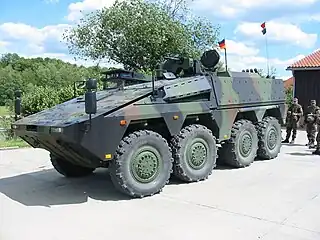 A prototype Boxer seen in 2004. Production deliveries were scheduled to commence in 2004, but numerous design changes combined with political problems delayed production until 2008
A prototype Boxer seen in 2004. Production deliveries were scheduled to commence in 2004, but numerous design changes combined with political problems delayed production until 2008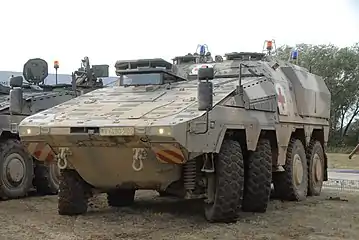 German Army Boxer in ambulance configuration. The German and Dutch base vehicles are virtually identical, mission modules and fitments the only significant difference.
German Army Boxer in ambulance configuration. The German and Dutch base vehicles are virtually identical, mission modules and fitments the only significant difference. German Boxer with FLW-200 remote weapon station
German Boxer with FLW-200 remote weapon station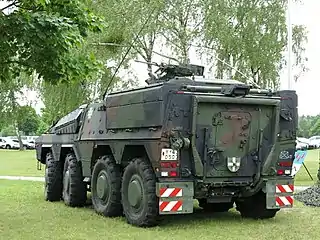 From the rear, a German Army Boxer fitted with a FLW 200 RWS
From the rear, a German Army Boxer fitted with a FLW 200 RWS Dutch Army Boxer in command post configuration - 36 of which were ordered
Dutch Army Boxer in command post configuration - 36 of which were ordered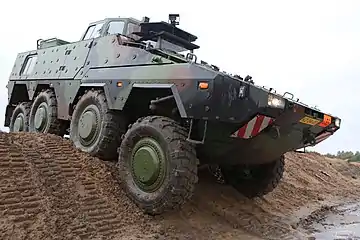 Dutch Army Boxer in driver training configuration
Dutch Army Boxer in driver training configuration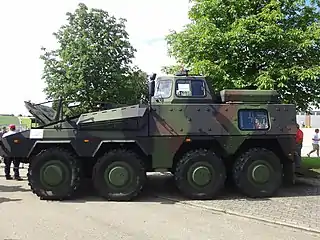 Driver training variant of Boxer; this variant has been ordered by Australia, Germany, Lithuania and the Netherlands
Driver training variant of Boxer; this variant has been ordered by Australia, Germany, Lithuania and the Netherlands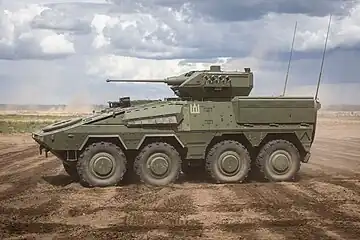 Lithuanian Army "Wolf" (Boxer) IFV.
Lithuanian Army "Wolf" (Boxer) IFV.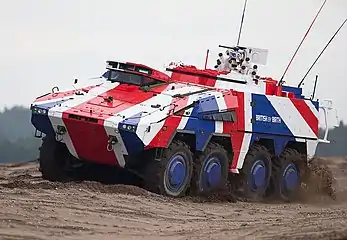 Boxer being showcased for the British Army's Mechanised Infantry Vehicle (MIV) requirement.
Boxer being showcased for the British Army's Mechanised Infantry Vehicle (MIV) requirement._-_10.jpg.webp) Four Boxer variants will fulfill the UK's Mechanised Infantry Vehicle (MIV) requirement, these being Mechanised Infantry Vehicle Protected Mobility (MIV-PM), Mechanised Infantry Vehicle Command and Control (MIV-CC), Mechanised Infantry Vehicle Ambulance (MIV-A), and Boxer Mechanised Infantry Vehicle Repair and Recovery (MIV-REC).
Four Boxer variants will fulfill the UK's Mechanised Infantry Vehicle (MIV) requirement, these being Mechanised Infantry Vehicle Protected Mobility (MIV-PM), Mechanised Infantry Vehicle Command and Control (MIV-CC), Mechanised Infantry Vehicle Ambulance (MIV-A), and Boxer Mechanised Infantry Vehicle Repair and Recovery (MIV-REC). Boxer configured for Australian Land 400 Phase 2 requirement.
Boxer configured for Australian Land 400 Phase 2 requirement. Skyranger 30
Skyranger 30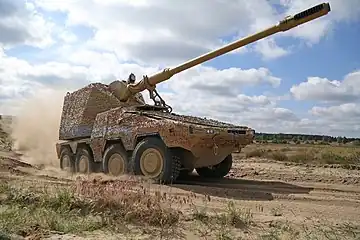 RCH155
RCH155 Skyranger 35
Skyranger 35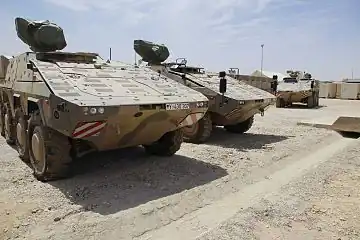 German Boxer vehicles in Afghanistan.
German Boxer vehicles in Afghanistan.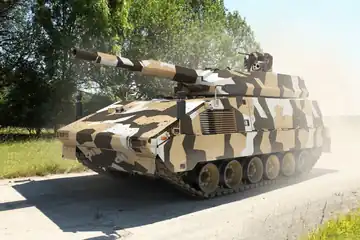 Tracked Boxer, RCT120 Mission Module
Tracked Boxer, RCT120 Mission Module
Operators
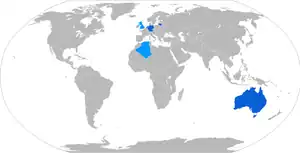
Current operators
.svg.png.webp) Australia: Australian Army – 211 vehicles on order, with deliveries expected until 2026.[81] Vehicles to be delivered under the Land 400 Phase 2 programme.[82][83] The first of 25 Boxers – 13 multipurpose and 12 turreted reconnaissance variants that are being manufactured in Germany through to 2021 to meet an early Australian capability requirement for familiarisation and training – were formally handed over to the army in September 2019. Prior to delivery the Boxers were modified locally with Australian-specific communications and battlefield management systems and fitted temporarily with the Kongsberg Protector RWS that previously equipped Australian ASLAVs deployed to Iraq and Afghanistan. Training with the first-delivered vehicles commenced by October 2020.[40] Production of the balance of 186 platforms – a mix of reconnaissance, command-and-control, joint fires, surveillance, ambulance, and battlefield repair and recovery variants – was scheduled to begin in late 2022 at RDA's Military Vehicle Centre of Excellence (MILVEHCOE) at Ipswich in Queensland, Rheinmetall's biggest facility outside Germany. To reduce integration risk, fitting the Australian-designed and produced Electro-Optic Systems R400 Mk 2 RWS to the 133 turreted reconnaissance variants is expected only after domestically produced 30 mm Lance turrets become available from the MILVEHCOE facility, probably sometime in 2023. During Boxer's selection process, protection received a higher priority than lethality. Lethality was followed by mobility, then by sustainability and C4ISR considerations.[56] Australia's Boxer CRV is scheduled to be filled with the Israeli Spike-LR2 anti-tank missile.[84]
Australia: Australian Army – 211 vehicles on order, with deliveries expected until 2026.[81] Vehicles to be delivered under the Land 400 Phase 2 programme.[82][83] The first of 25 Boxers – 13 multipurpose and 12 turreted reconnaissance variants that are being manufactured in Germany through to 2021 to meet an early Australian capability requirement for familiarisation and training – were formally handed over to the army in September 2019. Prior to delivery the Boxers were modified locally with Australian-specific communications and battlefield management systems and fitted temporarily with the Kongsberg Protector RWS that previously equipped Australian ASLAVs deployed to Iraq and Afghanistan. Training with the first-delivered vehicles commenced by October 2020.[40] Production of the balance of 186 platforms – a mix of reconnaissance, command-and-control, joint fires, surveillance, ambulance, and battlefield repair and recovery variants – was scheduled to begin in late 2022 at RDA's Military Vehicle Centre of Excellence (MILVEHCOE) at Ipswich in Queensland, Rheinmetall's biggest facility outside Germany. To reduce integration risk, fitting the Australian-designed and produced Electro-Optic Systems R400 Mk 2 RWS to the 133 turreted reconnaissance variants is expected only after domestically produced 30 mm Lance turrets become available from the MILVEHCOE facility, probably sometime in 2023. During Boxer's selection process, protection received a higher priority than lethality. Lethality was followed by mobility, then by sustainability and C4ISR considerations.[56] Australia's Boxer CRV is scheduled to be filled with the Israeli Spike-LR2 anti-tank missile.[84] Germany: German Army – 531 vehicles. The first German order consisted of 272 drive modules and 272 accompanying mission modules encompassing 125 APCs, 72 armoured medical treatment vehicles, 10 driver training vehicles, and 65 command vehicles.,[73] 128 Boxer CRV were ordered in March 2023, deliveries from 2025 on [71]
Germany: German Army – 531 vehicles. The first German order consisted of 272 drive modules and 272 accompanying mission modules encompassing 125 APCs, 72 armoured medical treatment vehicles, 10 driver training vehicles, and 65 command vehicles.,[73] 128 Boxer CRV were ordered in March 2023, deliveries from 2025 on [71] Lithuania: Lithuanian Land Force – 91 vehicles delivered by 2023[85], with additional purchase of 120 announced in April 2022. Lithuania received Boxers in the A2 configuration, 89 as variants of the baseline IFV configuration, plus two driver training vehicles. The IFV breakdown is: 55 IFV squad leader, 18 IFV platoon leader; 12 IFV company leader; 4 IFV command post. A single IFV is used for maintenance training. The first two vehicles (driver training configuration) were delivered to Lithuania in December 2017. In Lithuanian service these vehicles are known as IFV Vilkas (Vilkas being Lithuanian for wolf).[86][87][13][14][15] In April 2022 it was reported that Lithuania would purchase more than 120 additional Boxers.[88], which was confirmed in May 2023 [89]
Lithuania: Lithuanian Land Force – 91 vehicles delivered by 2023[85], with additional purchase of 120 announced in April 2022. Lithuania received Boxers in the A2 configuration, 89 as variants of the baseline IFV configuration, plus two driver training vehicles. The IFV breakdown is: 55 IFV squad leader, 18 IFV platoon leader; 12 IFV company leader; 4 IFV command post. A single IFV is used for maintenance training. The first two vehicles (driver training configuration) were delivered to Lithuania in December 2017. In Lithuanian service these vehicles are known as IFV Vilkas (Vilkas being Lithuanian for wolf).[86][87][13][14][15] In April 2022 it was reported that Lithuania would purchase more than 120 additional Boxers.[88], which was confirmed in May 2023 [89] Netherlands: Royal Netherlands Army – 200 vehicles, deliveries from 2013 until 2018. The last Dutch Boxer was produced in July 2018. Variant breakdown following a 2016 contract modification was 12 cargo, 92 engineer (12 of the 92 subsequently converted to Battle Damage Repair (BDR) configuration), 36 command post, 8 driver training, 52 ambulance.[73] An additional 38 vehicles are being procured as a result of the Defence Note 2022. Furthermore 10 vehicles will be ordered for the project Joint Electronic Attack. [90]
Netherlands: Royal Netherlands Army – 200 vehicles, deliveries from 2013 until 2018. The last Dutch Boxer was produced in July 2018. Variant breakdown following a 2016 contract modification was 12 cargo, 92 engineer (12 of the 92 subsequently converted to Battle Damage Repair (BDR) configuration), 36 command post, 8 driver training, 52 ambulance.[73] An additional 38 vehicles are being procured as a result of the Defence Note 2022. Furthermore 10 vehicles will be ordered for the project Joint Electronic Attack. [90]
Future operators
 Algeria: Algerian Army – production under license was reportedly to start in 2020, with 500 units to be produced by 2023.[91][92]
Algeria: Algerian Army – production under license was reportedly to start in 2020, with 500 units to be produced by 2023.[91][92] Ukraine: in September 2022 it was announced that Ukraine will purchase 18 Boxer RCH155s for €216m, funded from German aid.[93]
Ukraine: in September 2022 it was announced that Ukraine will purchase 18 Boxer RCH155s for €216m, funded from German aid.[93] United Kingdom: British Army - 623 vehicles from 2023. Following an announcement on 31 March 2018 by the UK government that it was re-joining the Boxer programme, the UK government announced on 3 April that Boxer had been selected by the British Army to meet its Mechanised Infantry Vehicle (MIV) requirement.[27][28] On 19 July the UK MoD disclosed its intent to order between 400 and 600 Boxers with options for a further 900, leading to a potential maximum procurement of 1500 vehicles.[94] The first vehicles are currently due to enter service in 2023.[73] As a result of the UK's intended larger order and its return to being a program partner, an option to build and export Boxers from the UK will be explored.[95][96] In January 2019 Rheinmetall announced that subject to government approvals the company would buy a 55% share of UK-based BAE Systems' land business for £28.6m. The joint venture (JV) is called Rheinmetall BAE Systems Land (RBSL) and is headquartered at BAE's existing facility in Telford, Shropshire.[97][98][99] On 5 November 2019, it was announced that a £2.3 billion deal for Boxer had been signed. There will be four variants, for a total of 523 units. Deliveries will start in 2023.[100][101][102] The UK will procure Boxer in three/four (source dependent) main variants. These are the baseline protected mobility (PM) variant (MIV-PM), a command and control (MIV-CC), an ambulance (MIV-A), and a repair/recovery (MIV-REP) variant. MIV-REP and MIV-REC (REC - recovery) are understood to have been combined into a repair and recovery vehicle retaining the MIV-REP designation.
United Kingdom: British Army - 623 vehicles from 2023. Following an announcement on 31 March 2018 by the UK government that it was re-joining the Boxer programme, the UK government announced on 3 April that Boxer had been selected by the British Army to meet its Mechanised Infantry Vehicle (MIV) requirement.[27][28] On 19 July the UK MoD disclosed its intent to order between 400 and 600 Boxers with options for a further 900, leading to a potential maximum procurement of 1500 vehicles.[94] The first vehicles are currently due to enter service in 2023.[73] As a result of the UK's intended larger order and its return to being a program partner, an option to build and export Boxers from the UK will be explored.[95][96] In January 2019 Rheinmetall announced that subject to government approvals the company would buy a 55% share of UK-based BAE Systems' land business for £28.6m. The joint venture (JV) is called Rheinmetall BAE Systems Land (RBSL) and is headquartered at BAE's existing facility in Telford, Shropshire.[97][98][99] On 5 November 2019, it was announced that a £2.3 billion deal for Boxer had been signed. There will be four variants, for a total of 523 units. Deliveries will start in 2023.[100][101][102] The UK will procure Boxer in three/four (source dependent) main variants. These are the baseline protected mobility (PM) variant (MIV-PM), a command and control (MIV-CC), an ambulance (MIV-A), and a repair/recovery (MIV-REP) variant. MIV-REP and MIV-REC (REC - recovery) are understood to have been combined into a repair and recovery vehicle retaining the MIV-REP designation.
- In terms of numbers, 285 personnel-carrying variants are on order, divided into 85 infantry carriers, 60 engineer section vehicles, 62 recce/fire support vehicles, and 28 mortar carriers. Another 50 of the APC variants are to be configured for equipment support as repair vehicles (MIV-REP) and these are dependent on source presented as the fourth variant. A total of 177 Boxer are ordered in the C4I configurations, again divided into 123 command-and-control (C2) and C2 utility vehicles, 19 observation post vehicles, 24 beyond-line-of-sight observation platforms, and 11 EW and SIGINT platforms. The remaining 61 are to be ambulances. A further 100 with no variant breakdown were announced in April 2022, bringing overall totals to 623.
See also
- Eitan AFV, 30-35 tons
- Freccia IFV
- VPK-7829 Bumerang. 34 tons
References
- "Progress and prospects for the protected transport vehicle GTK Boxer". Europäische Sicherheit & Technik. 7 February 2020. Retrieved 28 April 2020.
- "GTK/MRAV/PWV (Boxer) Wheeled Armoured Vehicle Programme". IHS Jane's Christopher F Foss. 21 October 2016. Retrieved 23 March 2017.
- "GTK/MRAV/PWV (Boxer) Wheeled Armoured Vehicle Programme (April 2022 updates)". Janes. 1 April 2022. Retrieved 7 April 2022.
- "MTU Shop". Mtu-online-shop.de. Retrieved 20 November 2014.
- "Rheinmetall MAN Military Vehicles GmbH". Rheinmetall Defence. Retrieved 10 September 2015.
- "Rheinmetall MAN Military Vehicles Nederland B.V." Rheinmetall Defence. Retrieved 10 September 2015.
- "Boxer MRAV Multi Role 8x8 Armoured Vehicle data fact sheet | Germany German army wheeled armoured vehicle UK | Germany German army military equipment UK". www.armyrecognition.com.
- "Land Warfare Platforms: Armoured Fighting Vehicles - Boxer (17 March 2021 updates)". Janes. Retrieved 22 March 2021.
- "German Parliament Approves Boxer Acquisition". Defense-update.com. Archived from the original on 13 February 2007. Retrieved 13 December 2006.
- "Germany orders 131 more Boxers". Jane's Defence Weekly. Retrieved 24 March 2017.
- "IAV 2020: BOXER - Interview with Stefan Lishka, MD of ARTEC". Janes. Retrieved 5 February 2020.
- "Boxer Janes AFVs". Janes. Retrieved 23 March 2021.
- "Lithuania has received two training Boxer APC". www.weaponnews.com. Lithuanian MoD. Retrieved 19 June 2017.
- "Boxer Lithuania". Janes. Retrieved 5 February 2020.
- "Boxer Jane's AFVs". Janes. Retrieved 5 February 2020.
- "Bundeswehr Boxer upgrade gets green light". Jane's Defence Weekly. Retrieved 28 June 2017.
- "Rheinmetall to modernize the Bundeswehr's Boxer command vehicles". Rheinmetall Group. Retrieved 4 July 2017.
- "Slovenia". Jane's. Retrieved 26 July 2019.
- "GTK/MRAV/PWV (Boxer) Wheeled Armoured Vehicle Programme (Sept 2019 updates". IHS Jane's. 20 September 2019. Retrieved 25 September 2019.
- Kerr, Julian (28 July 2016). "Australia shortlists AMV35, Boxer for future combat reconnaissance vehicle". Jane's IHS. Retrieved 29 July 2016.
- scheme=AGLSTERMS. AglsAgent; corporateName=Commonwealth of Australia, Department of Defence; address=Russell Offices. "Capability Acquisition & Sustainment Group | About | Department of Defence". www.defence.gov.au.
{{cite web}}: CS1 maint: multiple names: authors list (link) - McMahon, Amelia (12 March 2018). "LAND 400 Phase 2 decision revealed". Retrieved 14 March 2018.
- "Queensland trounces Victoria in bid for $5 billion Army deal". ABC News. 14 March 2018. Retrieved 14 March 2018.
- "Land 400 Phase 2" (PDF). Retrieved 1 July 2022.
- "Defence Connect". defence connect. 13 March 2018. Retrieved 13 March 2018.
- Grevatt, Jon (14 March 2018). "Rheinmetall's Boxer selected for Australia's Land 400 requirement". Jane's IHS. Retrieved 31 March 2018.
- Bebb, Guto (31 March 2018). "British Ministry of Defence announces they will re-join the Boxer programme". GOV.UK. Retrieved 31 March 2018.
- "British Army re-joins Boxer programme". Rheinmetall-defence.com. 3 April 2018. Retrieved 3 April 2018.
- Chuter, Andrew (26 October 2016). "Britain's Soft Spot for Germany's Boxer Vehicle Raises Eyebrows in Industry". Defense News. Retrieved 27 October 2016.
- Foss, Chris (29 November 2017). "German Boxers deploy to UK". Jane's JDW. Retrieved 7 December 2017.
- Tovey, Alan (4 February 2018). "UK jobs pledge in battle to win £2bn contract for new Army vehicle deal". The Telegraph. London, UK. Retrieved 5 February 2018.
- "Last Dutch Boxer rolls off production line". janes.com. 24 July 2018. Retrieved 31 July 2018.
- "Lithuanian Boxers enter trials". janes.com. 23 July 2018. Retrieved 31 July 2018.
- "UK orders 400-600". ted.europe.eu. 19 July 2018. Retrieved 23 July 2018.
- "Australian Government inspects first Australian Boxer vehicle at Rheinmetall in Kassel, Germany". rheinmetall-defence.com. 29 March 2019. Retrieved 29 March 2019.
- Eshel, Tamir (21 January 2019). "Iron Fists APS for the Australian Boxers".
- "Boxer CRV to get an Iron Fist?". 22 January 2019.
- "GTK/MRAV/PWV (Boxer) Wheeled Armoured Vehicle Programme (January 2021 updates". IHS Jane's. 7 January 2021. Retrieved 8 January 2021.
- "Production in West Midlands of British Army's new Boxer vehicle begins". 28 March 2023. Retrieved 26 May 2023.
- "Boxer JAFV Jan 2020-2021". Janes S Cranwell-Evans. 5 January 2021. Retrieved 7 January 2021.
- "Bundeswehr contracts Rheinmetall to upgrade more Boxer command vehicles". Janes. 15 February 2021. Retrieved 17 February 2021.
- Hoffmann, Lars (26 June 2020). "Jäger erhalten "Kampfboxer"". esut.de (in German). Retrieved 9 December 2022.
- "Schwerer Waffenträger Infanterie – Deutschland und Australien unterzeichnen Kooperationsvereinbarung". soldat-und-technik.de. 23 March 2023. Retrieved 24 May 2023.
- "New contract was signed to develop a new BOXER vehicle known as Joint Fire Support Team | OCCAR". www.occar.int. Retrieved 9 December 2022.
- "Thales delivers Panoramic Above Armour Gimbals (PAAG) to Krauss-Maffei Wegmann for German Boxer". www.defenceprocurementinternational.com. Retrieved 9 December 2022.
- Boxer armored vehicle production sets up tension between rising demand and supply bottleneck. Breaking Defense. 26 January 2023.
- Felstead, Peter (15 June 2016). "Eurosatory 2016: ST Kinetics launches Terrex 3 IFV". IHS Jane's. Archived from the original on 12 November 2016. Retrieved 11 November 2016.
- Foss, Christopher F (1 January 2016). "Patria awaits first contract for latest AMV XP". IHS Jane's. Archived from the original on 20 March 2016. Retrieved 11 November 2016.
- "VBCI: France's Wheeled APC". Defense Industry Daily. 13 October 2014. Retrieved 11 November 2016.
- Elbertzhagen, Timo. "GTK Boxer im Einsatz in Afghanistan – erste Erfahrungen" (PDF). Wehrtechnik. No. IV/2012. Mönch Publishing Group. Archived from the original (PDF) on 10 March 2014. Retrieved 23 September 2015.
- "Concerns for fleet of armoured vehicles deemed overweight and unprotected from missile attack". ABC News. 10 August 2021.
- "Schwerer Waffenträger Infanterie – Deutschland und Australien unterzeichnen Kooperationsvereinbarung". soldat-und-technik.de (in German). 23 March 2023. Retrieved 25 March 2023.
- Nitschke, Stefan. "Schutz bei Rad- und Kettenfahrzeugen – Teil 1" (PDF). Wehrtechnik. No. Wehrtechnik I 2011 page 52-57. Mönch Publishing Group. Archived from the original (PDF) on 13 September 2011. Retrieved 23 September 2015.
- "GTK/MRAV/PWV (Boxer) Wheeled Armoured Vehicle Programme Jan 2018". IHS Jane's Christopher F Foss. 9 January 2018. Retrieved 26 January 2018.
- "GTK/MRAV/PWV (Boxer) Wheeled Armoured Vehicle Programme May 2017". IHS Jane's Christopher F Foss. 3 May 2017. Retrieved 3 May 2017.
- "Boxer JAFV 2020-2021". Janes S Cranwell-Evans. 25 August 2020. Retrieved 11 September 2020.
- "Boxer Jane's Armoured Fighting Vehicles January 2020 updates". Jane's. 23 January 2020. Retrieved 11 February 2020.
- "artec-boxer.com: Command Post Vehicles". Artec-boxer.com. Retrieved 20 November 2014.
- "Australian DoD rebuts claim that weight issues could affect turret integration on Boxer CRVs". Janes.com. Retrieved 30 April 2023.
- "Australia begins local production of Boxer CRVs". Janes.com. Retrieved 30 April 2023.
- "Report: Germany in talks to purchase Australian-made CRVs with Israeli systems". Israel Defense. 6 March 2023. Retrieved 30 April 2023.
- "Schwerer Waffenträger Infanterie – Deutschland und Australien unterzeichnen Kooperationsvereinbarung". soldat-und-technik.de (in German). 23 March 2023. Retrieved 30 April 2023.
- "Boxer Armoured Vehicle - Details and Variants - Think Defence". www.thinkdefence.co.uk. 5 November 2022. Retrieved 30 April 2023.
- Hamer, Nicky (23 December 2019). "Australian company (EOS) awarded multi-million dollar contract for Army's Boxer vehicles". Australian Government Defence. Retrieved 30 April 2023.
- "EOS Wins Australian RWS Contract for LAND 400 Phase 2". Overt Defense. 8 January 2020. Retrieved 30 April 2023.
- "artec-boxer.com: Armoured Engineer Group Vehicle". Artec-boxer.com. Retrieved 20 November 2014.
- "artec-boxer.com: Battle Damage Repair Vehicle". Artec-boxer.com. Retrieved 20 November 2014.
- Gerhard Heiming: Erster Boxer in Transportversion, Europäische Sicherheit & Technik, Ausgabe 5/2016, S. 7.
- "artec-boxer.com: Cargo Vehicle". Artec-boxer.com. Retrieved 20 November 2014.
- "artec-boxer.com: Driver Training Vehicle". Artec-boxer.com. Retrieved 20 November 2014.
- "Schwerer Waffenträger Infanterie – Deutschland und Australien unterzeichnen Kooperationsvereinbarung". 23 March 2023.
- "German Boxer vehicles to get Thales surveillance system". Janes. Retrieved 6 April 2022.
- "Land Warfare Platforms: Armoured Fighting Vehicles - Boxer (07 April 2021 updates)". Janes. Retrieved 7 April 2021.
- "Countering RAM, drones and other flying objects with highly mobile assets, Rheinmetall's solutions". July 2022.
- "Boxer". IHS Jane's. 3 March 2021. Retrieved 4 March 2021.
- "Brimstone equipped boxer vehicle variant revealed". ukdefencejournal. 21 September 2022. Retrieved 10 January 2023.
- "DVD 2022: RBSL unveils Boxer Overwatch demonstrator". Janes. 26 September 2022. Retrieved 26 October 2022.
- Lye, Harry (10 February 2021). "Lockheed Martin UK unwraps future anti-armour concept". Army Technology. Retrieved 25 October 2023.
- "Mounted Close Combat Overwatch (MCCO) - Think Defence". www.thinkdefence.co.uk. 4 February 2023. Retrieved 25 October 2023.
- "Update: Eurosatory 2022 – KMW presents tracked version of Boxer". Janes. 17 June 2022. Retrieved 26 October 2022.
- "Land Combat Vehicle System : Equipping Defence : Department of Defence". www.defence.gov.au. Archived from the original on 28 February 2020. Retrieved 29 February 2020.
- "Joint media release - Prime Minister, Minister for Defence Industry and Minister for Defence - New Vehicles to protect our troops and create 1450 jobs". 14 March 2018. Retrieved 15 March 2018.
- Dominguez, Gabriel (17 August 2018). "Australia orders 211 Boxer wheeled armoured vehicles". Janes. Archived from the original on 17 August 2018. Retrieved 18 August 2018.
- Kelly, Fergus (31 May 2018). "Australia's new Boxer CRVs will carry Israel's Spike LR2 anti-tank missiles". The Defense Post. Retrieved 22 August 2022.
- "Lithuania to proceed with Germany's Boxer in armoured vehicle purchase". Reuters. 11 December 2015. Retrieved 11 December 2015.
- "Lithuania joins Boxer programme". www.yourindustrynews.com. OCCAR. Archived from the original on 23 August 2016. Retrieved 22 August 2016.
- "Minister J. Olekas: "The Contract of 88 IFV is the signal that Lithuania takes care of its security and investments into it seriously". Ministry of National Defence of the Republic of Lithuania. 22 August 2016. Archived from the original on 5 October 2016. Retrieved 22 August 2016.
- "Lithuania launches talks to buy more than 120 Boxer Vilkas military vehicles". Defence.com. 21 April 2022. Retrieved 21 April 2022.
- admin (9 May 2023). "Lithuania Ministry of Defense to Order 120 Additional Vilkas Infantry Fighting Vehicles". MilitaryLeak. Retrieved 11 May 2023.
- (PDF) https://www.defensie.nl/binaries/defensie/documenten/publicaties/2023/09/19/defensie-projectenoverzicht-2023/DPO-Rapportage-2023.pdf.
{{cite web}}: Missing or empty|title=(help) - "Towards the Start of Production of the IFV Boxer in Algeria". www.defense-aerospace.com.
- "Algeria will reportedly produce Boxer vehicles under license". 7 May 2019.
- "RCH 155 SPH For Ukraine". European Security & Defense. 20 September 2022. Retrieved 9 December 2022.
- "UK orderSustainment". ted.europe.eu. 19 July 2018. Retrieved 23 July 2018.
- "British companies get green light to press ahead with new Army vehicle plans, Defence Minister announces". Gov.uk. 19 September 2018. Archived from the original on 19 September 2018. Retrieved 23 September 2018.
- Cranny-Evans, Samuel (21 September 2018). "DVD 2018: UK proceeds with Boxer procurement". IHS Jane's 360. London. Archived from the original on 21 September 2018. Retrieved 23 September 2018.
- "Rheinmetall, BAE Systems launch joint venture for military vehicles". Defense News. 22 January 2019. Retrieved 25 January 2019.
- "Rheinmetall, BAE Systems to form UK-based JV". Shephard Media. Retrieved 25 January 2019.
- "BAE Systems sells control of vehicles arm to Rheinmetall". BBC News. 21 January 2019. Retrieved 25 January 2019.
- "BOXER for the British Army". army.mod.uk. 5 November 2019.
- "UK Joins the BOXER Family". occar.int. 5 November 2019.
- "Defence firm Thales UK wins 'threat detection' contract". bbc.co.uk. 19 February 2021. Retrieved 21 February 2021.